Students can go through the detailed revision notes to strengthen their understanding of genetics and inheritance. The Principles of Inheritance and Variation Class 12 Notes cover important topics such as Mendelian laws of inheritance, types of dominance, multiple alleles, sex-linked traits, mutations, chromosomal aberrations, and pedigree analysis. Careers360 provides clear summaries, diagrams, tables, and examples, and all the topics included in the NCERT.
NCERT Class 12 Biology Chapter 5 Notes Principles of Inheritance and Variation
Have you ever wondered why children sometimes inherit traits that are different from those of both parents? The NCERT Class 12 Biology Chapter 4 Notes Principles of Inheritance and Variation, provide clear explanations and summaries for easy learning, and explain how traits are passed on and why variations appear. These notes cover topics like genetic linkage, crossing over, and chromosomal aberrations. The NCERT Notes are prepared by subject experts for quick revision and help students understand complex concepts effectively.
This Story also Contains
- NCERT Class 12 Biology Chapter 4 Notes: Download PDF
- Class 12 Biology Chapter 4 Principles of Inheritance and Variation Notes
- Chapter 4 Principles of Inheritance and Variation: Previous Year Question and Answers
- How to Use NCERT Class 12 Biology Chapter 4 Notes Effectively?
- Advantages of Principles of Inheritance and Variation Class 12 Notes
- Chapter-Wise NCERT Class 12 Notes Biology
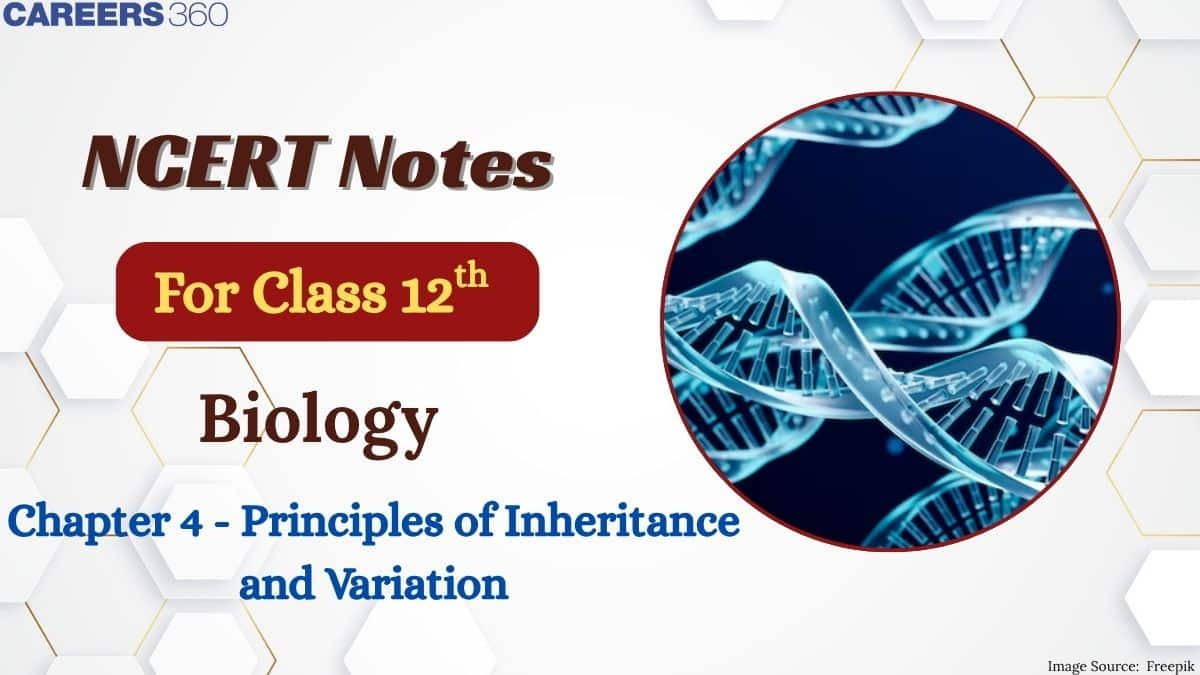
NCERT Class 12 Biology Chapter 4 Notes also include real-life examples and solved previous year questions to strengthen the understanding of inheritance and variation. By going through the well-labeled diagrams and flow charts in the notes, students can understand the Mendelian laws, test cross, incomplete dominance, codominance, mutations, and pedigree analysis. Regular use of these NCERT Notes for Class 12 helps in understanding the important concepts rather than just memorizing, which is important for performing well in exams.
Note: This chapter is renumbered as Chapter 4 in the NCERT Class 12 Biology textbook as per the latest syllabus.
NCERT Class 12 Biology Chapter 4 Notes: Download PDF
These notes make it easier to understand how traits are inherited and how variations arise in organisms. The NCERT Class 12 Biology Chapter 4 Notes Principles of Inheritance and Variation, PDF can be downloaded for convenient study anytime, helping students revise efficiently. With clear explanations and examples, these NCERT Notes for Class 12 Biology break down the complex concepts and support quick and effective exam preparation.
Download PDFAlso check:
Class 12 Biology Chapter 4 Principles of Inheritance and Variation Notes
Law of Inheritance or Mendel’s Laws of Inheritance
Who is the Father of Genetics? The answer is Gregor Johann Mendel.
- Genetics is the study of principles and mechanisms of heredity and variation.
- Inheritance is the process by which characteristics are passed on from parent to progeny. It is the basis of heredity.
Variation is the degree to which progeny differ from their parents. Variation may be in terms of morphology, physiology, cytology, and behavioral traits of individuals belonging to the same species.
Variation arises due to
Reshuffling of genes/chromosomes.
Crossing over or recombination
Mutation and the effect of the environment.
Selection of pea plant:
The main reasons for adopting the garden pea (Pisum sativum) for experiments by Mendel were –
Pea has many distinct and contrasting characters.
The life span of pea plants is short.
Pea plant flowers show self-pollination and reproductive whorls being enclosed by the corolla.
It is easy to artificially cross-pollinate the pea flowers, and they were fertile too.
How is Mendel’s method working?
Mendel’s success was also due to his meticulous planning and method of work –
Mendel studied only one character at a time for a deep evaluation.
He used all available techniques to avoid cross-pollination by undesirable pollen grains.
He applied mathematics and statistics as well to analyze the results obtained by him.
Mendel selected 7 contrasting characters of a garden pea for his hybridization experiments and studied their contrasting characters.
S. No. | Character | Contrasting character (Dominant/Recessive) |
1 | Stem height | Tall/Dwarf |
2 | Flower colour | Violet/White |
3 | Flower position | Axial/Terminal |
4 | Pod shape | Inflated/Constricted |
5 | Pod colour | Green/Yellow |
6 | Seed shape | Round/wrinkled |
7 | Seed colour | Yellow/Green |
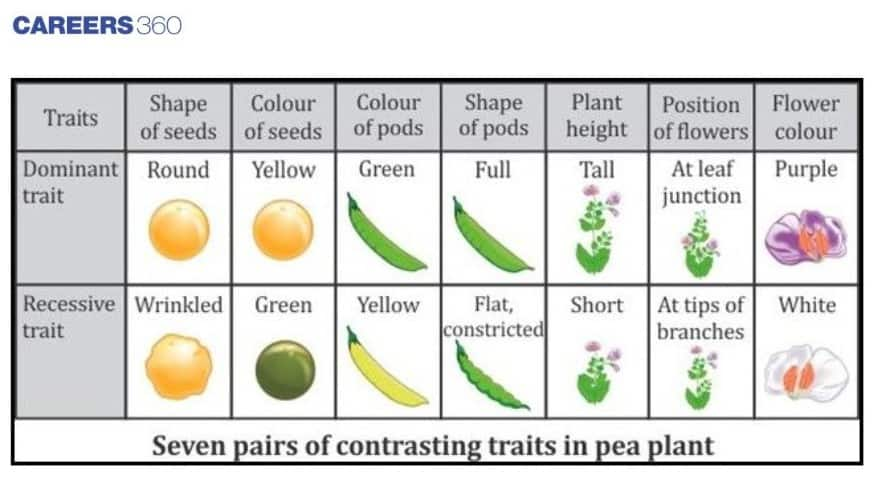
Mendel conducted artificial hybridization/cross-pollination using true-breeding pea lines. True breeding lines are those that undergo continuous self-pollination and show stable trait inheritance.
A hybridization experiment includes emasculation (removal of anthers) and transfer of pollen (pollination).
Inheritance of one gene (Monohybrid cross)
Mendel crossed tall and dwarf pea plants and collected all the seeds obtained from this cross, then he grew all the seeds to generate plants of the first hybrid generation, which will be called the F1 generation, and then he observed that all the plants had tall characteristics. A similar observation was also found in other pairs of traits.
Mendel self-pollinated the F1 plants and found that in the F2 generation, some plants were also dwarf. The proportion of dwarf plants is 1/4th, and tall plants are 3/4th.
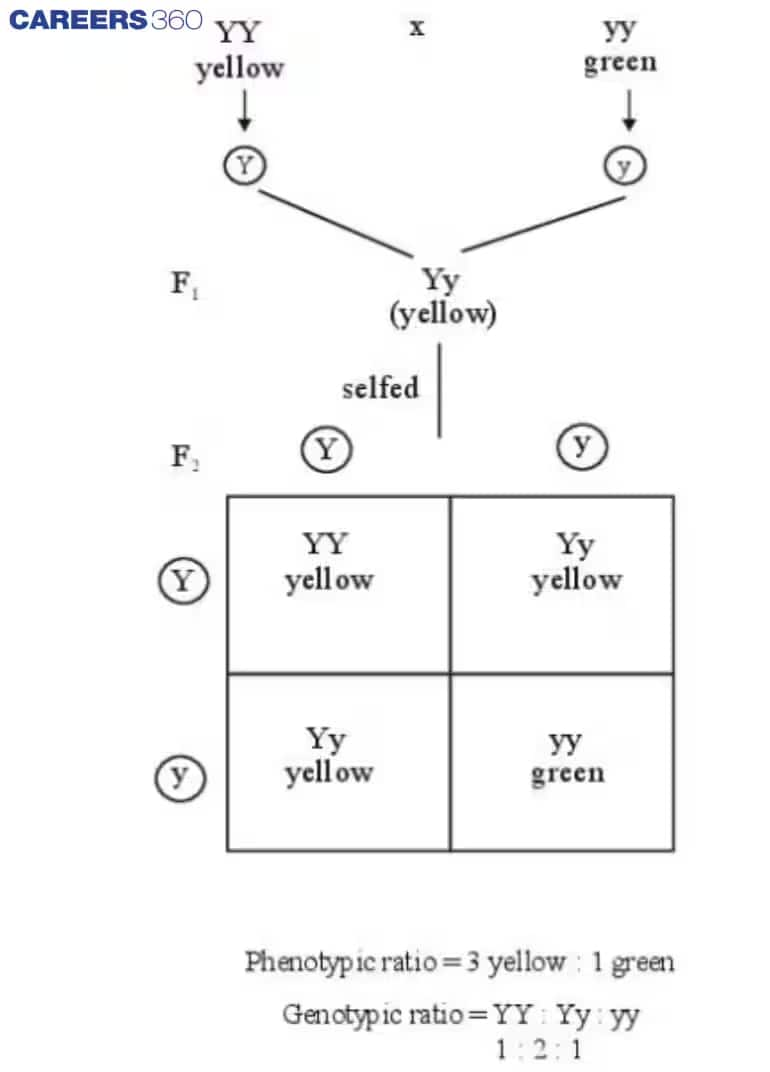
Mendel called these factors 'factors' that are passed from one generation to the next. Nowadays, it is called a gene (unit of inheritance).
Genes that code for a pair of contrasting traits and then they will be called alleles.
He used alphabetical symbols to represent each gene, for example, a capital letter (TT) for a gene expressed in the F1 generation and a small letter (tt) for other genes.
Mendel also proposed that in true-breeding tall and dwarf varieties, an allelic pair of genes for height is homozygous (TT or tt). TT, Tt, or tt are called genotypes, and characteristics like tall and dwarf are called phenotypes.
The hybrids that contain alleles that express contrasting traits are called heterozygous (Tt).
The monohybrid ratio of the F2 hybrid is 3:1 (phenotypic) and 1:2:1 (genotypic).
Test cross
A test cross is the cross between an individual with a dominant trait and a recessive organism in order to know whether the dominant trait is homozygous or heterozygous.
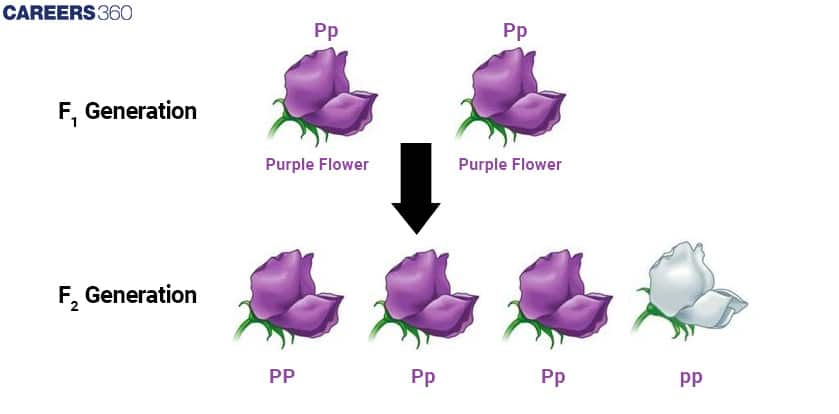
Laws Based on Monohybrid Cross
This is based on observations of a monohybrid cross. Mendel proposed two laws of inheritance-
1. Law of dominance: This law states;
Characters are controlled by discrete units called factors.
Factors always occur in pairs.
In a dissimilar pair of factors, one member of the pair dominates the other.
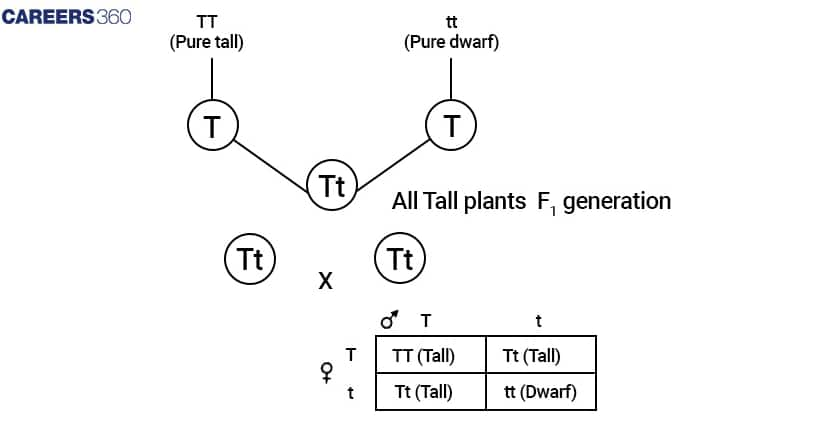
Dominance | Recessive | |
(i) | When a factor (allele) expresses itself in the presence or absence of its dominant factor, it is called dominance. | It can only express itself in the absence of or in the presence of its recessive factor allele. |
(ii) | It forms a complete functional enzyme that perfectly expresses itself. | It forms an incomplete defective enzyme that fails to express itself when present with its dominant allele, i.e., in a heterozygous condition. |
2. Law of Segregation:
According to the Law of Segregation, alleles do not blend, and both characters are recovered during gamete formation, as in the F2 generation.
In gamete formation, traits segregate (separate) from each other and produce different kinds of gametes. Homozygous gametes produce similar kinds of gametes, whereas heterozygous gametes produce different kinds of gametes with different traits.
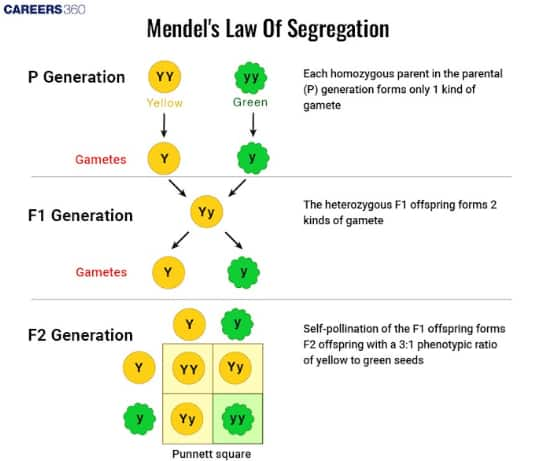
Incomplete dominance
It is a post-Mendelian discovery. The phenomenon of incomplete dominance occurs when neither of the two alleles is dominant, so the hybrid expression is a fine mixture or intermediate expression between the two alleles.
In snapdragon (Mirabilis jalapa), there are two types of pure breeding plants, red-flowered and white-flowered. On crossing the two, F1 plants possess pink flowers. On selfing them, the F2 generation has 1 red: 2 pink: 1white. The pink flower is due to incomplete dominance.
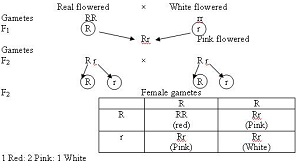
Co-dominance
It is the phenomenon of two alleles lacking a dominance-recessive relationship and both expressing themselves in the organism.
Human beings, ABO blood grouping is controlled by gene I. The gene has three alleles: IA, IB, and i. Any person contains any two of the three alleles IA, IB, which are dominant over i.
The plasma membrane of the red blood cells has sugar polymers that protrude from its surface, and the kind of sugar is controlled by the gene.
When IA and IB are present together, both express their own types of sugars because of co-dominance.
Difference Between Incomplete and Co-Dominance
Incomplete Dominance | Co-Dominance | ||
1. | The effect of one of the two alleles is more conspicuous. | 1. | The effects of both alleles are equally conspicuous in co-dominance. |
2. | It produces a mixture of the expression of two alleles. | 2. | There is no mixing of the effects of the two alleles. |
3. | The F1 does not resemble either of the parents. | 3. | The F1 resembles both parents. |
4. | E.g.: Flower colour in dog flower. | 4. | E.g.: ABO blood grouping in humans, |
Multiple Alleles
There are multiple forms of a Mendelian factor or gene that occur on the same gene locus distributed in different organisms in the gene pool, with an organism carrying only two alleles and a gamete only one allele. ABO blood grouping also provides a good example of multiple alleles.
Inheritance of two genes (Dihybrid Cross)
When a cross was made to study the simultaneous inheritance of two pairs of Mendelian factors of genes.
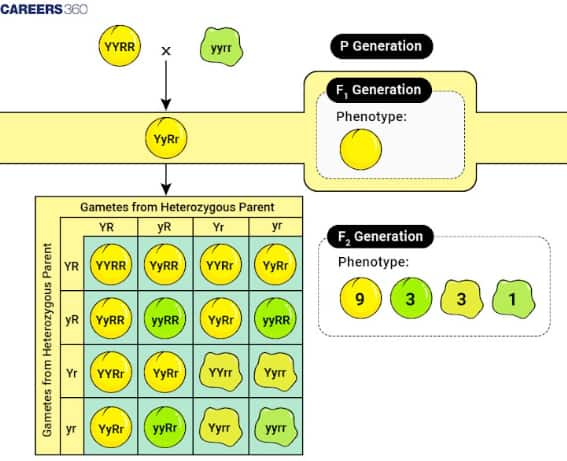
Law of Independent Assortment:
The Law of Independent Assortment states that ‘when two pairs of traits are combined in a hybrid, segregation of one pair of characters is independent of the other pair of characters. In the Dihybrid cross, two new combinations, round green & wrinkled yellow, are formed due to an independent assortment of traits for seed shape, i.e., round, wrinkled, and seed color, i.e., yellow and green.
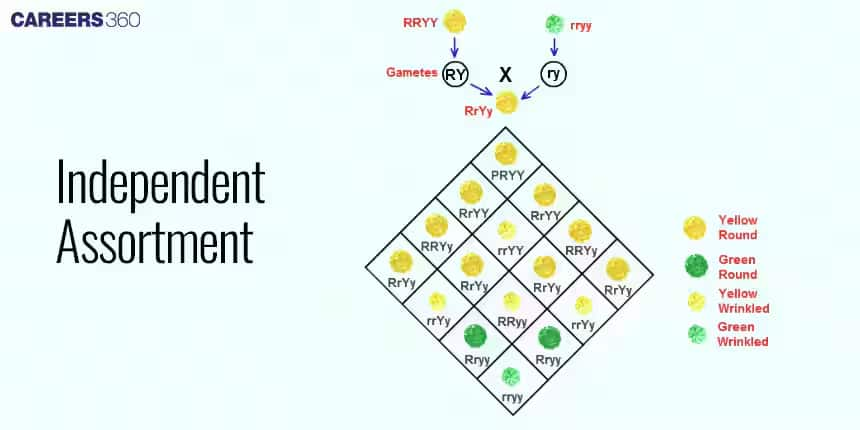
The ratio of 9:3:3:1 can be derived as a combination series of:
9 round yellow
3 round green
3 wrinkled yellow
1 wrinkled green
Chromosomal Theory of Inheritance
Chromosome, as well as genes, occurs in pairs. The two alleles of a gene pair are located on the same locus on homologous chromosomes.
Sutton and Boveri argued that the pairing and separation of a pair of chromosomes would lead to the segregation of a pair of factors (genes) they carried.
Sutton united the knowledge of chromosomal segregation with Mendelian principles and called it the chromosomal theory of inheritance.
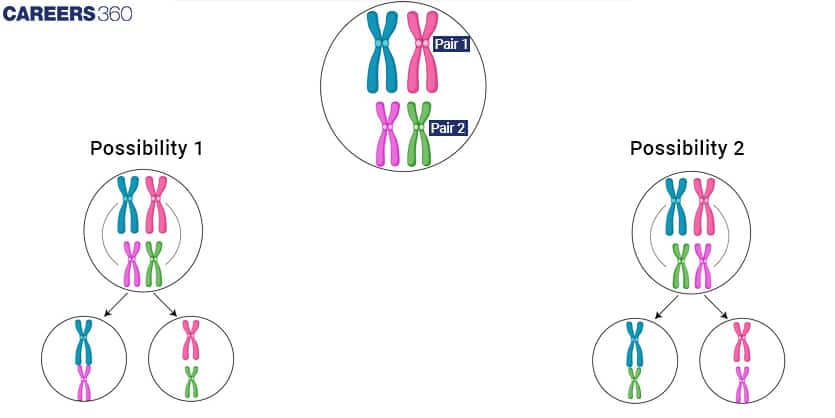
Linkage and Recombination
The concept of linkage and recombination is explained below:
When two genes in a Dihybrid cross were situated on the same chromosome, the proportion of parental gene combinations was much higher than the non-parental type. Morgan attributed this to the physical association or the linkage of the two genes and coined the term " linkage to describe the physical association of genes on the same chromosome.
The generation of non-parental gene combinations during a Dihybrid cross is called recombination. When genes are located on the same chromosome, they are tightly linked and show very low recombination.
The difference between crossing over and linkage
Crossing over | Linkage |
1. It leads to the separation of linked genes | 1. keeps the genes together |
2. The process involves the exchange of segments between non-sister chromatids on homologous chromosomes. | 2. It involves individual chromosomes. |
3. The frequency of crossing over can never exceed 50%. | 3. It is impossible for the number of linkage groups to exceed the number of haploid chromosomes. |
4. It increases variability by forming new gene combinations. | 4. It reduces variability. |
Sex Determination
Henking in 1891 observed a trace of specific nuclear structure in a few insects. Furthermore, he observed that this specific nuclear structure is only found in 50% of sperm. He called this ‘x’ body. He was not able to explain its significance.
Later, it was observed that the ovum that receives the sperm with X body becomes female and those that do not become males, so this X body was called a sex chromosome, and other chromosomes are called autosomes.
In humans and other organisms, XY types of sex determination are seen, but in some insects, like Drosophila, the XO type of sex determination is present.
In both types of sex determination, males produce two different types of gametes, either with or without an X chromosome, or some with an X chromosome and some with a Y chromosome. Such types of sex determination are called male heterogamety.
In birds, the ZW type of sex determination is present. Two different types of gametes are produced by females in terms of sex chromosomes; this type of sex determination is called female heterogamety.
Sex determination in human beings is of the XY type. Out of 23 pairs of chromosomes, 22 pairs are exactly the same in males and females, called autosomes. A pair of X chromosomes is present in females and XY in males. During spermatogenesis, males produce two types of gametes (sperms): 50% carry the Y chromosome, and the remaining 50% contain the X chromosome. Females produce only one kind of gamete (ovum) with X chromosomes only.
When sperm has a Y chromosome, the sex of the baby is male, and when sperm carrying the X chromosome fertilise the egg, the sex of the baby is female.
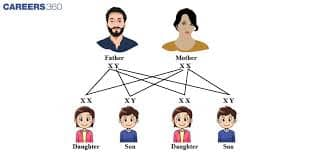
Mutation
A Mutation is a phenomenon that results in an alteration of the DNA sequence and consequently results in a change in the genotype and phenotype of an organism. The mutations that arise due to a change in a single base pair of DNA are called point mutations, e.g., Sickle cell anemia.
Pedigree Analysis
The analysis of traits in several generations of a family is called the pedigree analysis. The inheritance of a particular trait is represented in the family tree over several generations. It is used to trace the inheritance of a particular trait, abnormalities, and diseases.
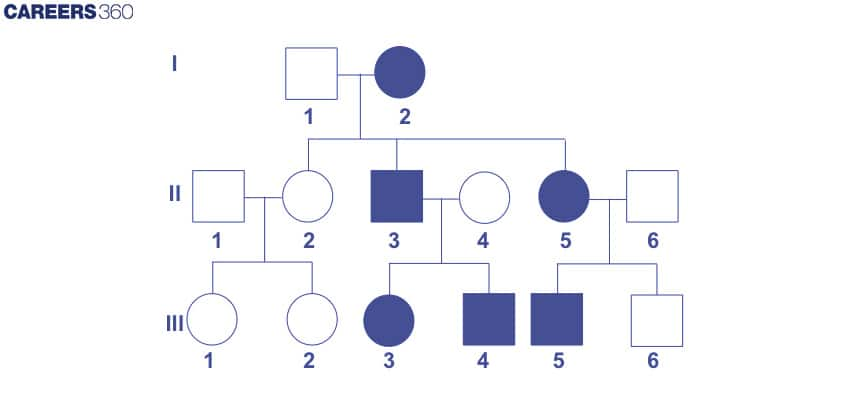
Genetic Disorders
Broadly, human genetic disorders may be grouped into two categories –
Mendelian disorders
Chromosomal disorders.
These disorders are transmitted as the affected individual is sterile. This is always dominant in nature.
Mendelian Disorders | Chromosomal disorders |
These are due to alterations in a single gene. | They are caused by the presence or absence of one or more chromosomes or by the abnormal arrangement of one or more chromosomes. |
Through Mendelian inheritance, they are transmitted from generation to generation. | They may be recessive or dominant in nature. |
Examples: Colour blindness, Phenylketonuria. | Examples: Down syndrome, Turner’s syndrome |
Mendelian disorders include
Haemophilia-
Haemophilia is a sex-linked recessive disease in which, in an infected individual, a minor cut leads to non-stop bleeding. Heterozygous females (carriers) can transmit the disease to their sons. Whether or not a female will become hemophilic is extremely unlikely because the mother would have to be at least a carrier, while the father would have to be hemophilic (unviable in later years).
Sickle cell anemia-
Sickle cell anemia is an autosomal recessive trait in which mutant hemoglobin molecules undergo polymerization under low oxygen tension, changing the shape of the red blood cell from a biconvex disc to an elongated sickle-like structure. It results from the substitution of Glutamic acid (Glu) by Valine (Val) at the sixth position of the beta-globin chain of the hemoglobin molecule. The single base substitution of GAG to GUG occurs at the sixth codon of the beta-globin gene.
Phenylketonuria-
Phenylketonuria is an inborn error of metabolism inherited as an autosomal recessive trait. The affected individual lacks an enzyme that converts the amino acid phenylalanine to tyrosine. As a result of this, phenylalanine is accumulated and converted into phenylpyruvic acid and other derivatives that result in intellectual retardation.
Chromosomal Disorders
- Failure of segregation of chromatids during cell division results in loss or gain of a chromosome, called aneuploidy.
- The failure of cytokinesis leads to two sets of chromosomes, called polyploidy.
Down’s Syndrome–
This syndrome occurs due to the presence of an additional copy of chromosome 21. The affected individual is short-statured with a small, rounded head, furrowed tongue, and partially opened mouth. Mental development is retarded.
Klinefelter’s Syndrome–
This syndrome occurs due to the presence of an additional copy of the X chromosome (XXY). Such persons have overall masculine development; however, the feminine development (development of breast, i.e., Gynaecomastia) is also expressed, and they are also sterile.
Turner’s Syndrome-
This syndrome occurs due to the absence of one of the X chromosomes. So an individual will have 45 with XO, such females are sterile as their ovaries are rudimentary. They lack secondary sexual characters.
Also, Read
Chapter 4 Principles of Inheritance and Variation: Previous Year Question and Answers
Previous years’ questions from this chapter are listed below. Students can understand important concepts of inheritance, variation, and related genetic principles by studying the Principles of Inheritance and Variation Class 12 Notes.
Question 1. Relative Biological Effectiveness (RBE) usually refers to damage caused by
Option 1. Low temperature
Option 2. High temperature
Option 3. Encephalitis
Option 4. Radiation
Answer :
Relative Biological Effectiveness (RBE) is a measure used in radiation biology to compare the biological damage caused by different types of radiation. It determines the effectiveness of a specific radiation type in causing harm compared to a reference radiation. RBE values vary for different radiation sources, with high-energy particles having higher RBE than low-energy photons. Thus, RBE is used to assess the damage caused by radiation.
Hence, the correct answer is option (4), Radiation
Question 2. In recent years, DNA sequences (nucleotide sequences) of mtDNA (Mitochondrial DNA) and Y-chromosomes were considered for the study of human evolution, because
Option 1. Their structure is known in greater detail
Option 2. They can be studied from the samples of fossil remains
Option 3. They are small and therefore, easy to study (they are uniparental in origin and do not take part in recombination
Option 4. They are uniparental in origin and do not take part in recombination
Answer :
Wilson and Sarich chose mitochondrial DNA (mtDNA) for the study of maternal line inheritance. At the same time, Y-chromosomes were considered for the study of human evolution, particularly in the male domain. It is possible because they are uniparental in origin and do not take part in recombination.
Hence, the correct answer is option (4). They are uniparental in origin and do not take part in recombination
Question 3. Inversions are considered as crossover suppressors because
Option 1. Homozygous inversions are lethal and thus do not appear in the next generation.
Option 2. Inversion heterozygotes, i.e., one copy having the normal chromosome and its homolog having an inversion, do not allow crossing over to occur as they cannot pair at all.
Option 3. Due to inversion present, four chromosomes take part in the pairing and crossing over events, making the structure difficult to separate and leading to gamete formation.
Option 4. The pairing and crossing over do occur in inversion heterozygotes, but the gametes that have crossover products are lethal.
Answer :
In inversion heterozygotes, crossing over can still occur, but it produces abnormal recombinant gametes with duplications or deletions. These gametes are usually non-viable, so effectively, inversions suppress the production of viable crossover products, preventing them from contributing to the next generation.
Hence, the correct answer is option (4). The pairing and crossing over do occur in inversion heterozygotes, but the gametes that have crossover products are lethal.
Question 4. In a Mendelian dihybrid cross, the phenotypic ratio obtained in the F₂ generation is
Option 1. 9 : 3 : 3 : 1
Option 2. 3 : 1
Option 3. 1 : 2 : 1
Option 4. 9 : 7
Answer :
In a dihybrid cross involving two independently assorting traits, Mendel observed four different phenotypes in the F₂ generation. This results in a characteristic phenotypic ratio of 9:3:3:1, which supports the law of independent assortment.
Hence, the correct answer is option (1), 9 : 3 : 3 : 1
Question 5. Which of the following disorders is caused due to a recessive gene located on the X chromosome?
Option 1. Thalassemia
Option 2. Sickle cell anaemia
Option 3. Colour blindness
Option 4. Phenylketonuria
Answer :
Colour blindness is an X-linked recessive disorder. Since males have only one X chromosome, a single defective gene is enough to express the condition, making it more common in males than in females.
Hence, the correct answer is option (3), Colour blindness
Also Read:
How to Use NCERT Class 12 Biology Chapter 4 Notes Effectively?
Understanding how traits are passed from parents to offspring helps in learning the basics of genetics and variation. These concepts form the foundation of heredity and are important for solving related problems in exams.
- Go through the laws of inheritance, Mendelian ratios, and different types of inheritance from the Class 12 Biology Chapter 4 Principles of Inheritance and Variation Notes.
- Study examples of genetic disorders and variations to understand how traits are inherited differently in organisms.
- Pay attention to the role of chromosomes, genes, and mutations in creating variations among individuals.
- Explore the pedigree analysis to track inheritance patterns and predict the occurrence of traits in families.
- Regularly revise the Class 12 Biology Chapter 4 Principles of Inheritance and Variation Notes and practice solving problems.
Advantages of Principles of Inheritance and Variation Class 12 Notes
The chapter Principles of Inheritance and Variation explains how traits are transmitted from one generation to another and how variations arise in organisms. Well-structured notes help students understand genetic laws, inheritance patterns, and their applications.
Class 12 Biology Chapter 4 Principles of Inheritance and Variation Notes PDF simplifies Mendel’s laws of inheritance with clear explanations and examples.
The notes help in understanding genetic disorders, mutations, and chromosomal variations.
Diagrams and tables are also included in the notes, which make complex crosses and ratios easier to remember.
Regular revision using these notes improves accuracy in numerical and case-based questions, which are frequently asked in the exams.
Class 12 Biology Chapter 4 Principles of Inheritance and Variation Notes PDF are highly useful for board exams and competitive exams like NEET.
Chapter-Wise NCERT Class 12 Notes Biology
Provided below is a table that includes chapter-wise notes. These notes explain all chapters in a simple way with important points and diagrams. Revision becomes easier and faster with these summaries.
| NCERT Class 12 Biology Chapter 1 Sexual Reproduction in Flowering Plants Notes |
| NCERT Class 12 Biology Chapter 2 Human Reproduction Notes |
| NCERT Class 12 Biology Chapter 3 Reproductive Health Notes |
| NCERT Class 12 Biology Chapter 4 Principles of Inheritance and Variation Notes |
| NCERT Class 12 Biology Chapter 5 Molecular Basis of Inheritance Notes |
| NCERT Class 12 Biology Chapter 6 Evolution Notes |
| NCERT Class 12 Biology Chapter 7 Human Health and Disease Notes |
| NCERT Class 12 Biology Chapter 8 Microbes in Human Welfare Notes |
| NCERT Class 12 Biology Chapter 9 Biotechnology: Principles and Processes Notes |
| NCERT Class 12 Biology Chapter 10 Biotechnology and its Applications Notes |
| NCERT Class 12 Biology Chapter 11 Organisms and Populations Notes |
| NCERT Class 12 Biology Chapter 12 Ecosystem Notes |
| NCERT Class 12 Biology Chapter 13 Biodiversity and Conservation Notes |
Frequently Asked Questions (FAQs)
It is the cross between an individual with a dominant trait and a recessive organism in order to know whether the dominant trait is homozygous or heterozygous.
In NCERT Class 12 Biology Chapter 4 Notes Principles of Inheritance and Variation, law of dominance states that:
Characters are controlled by discrete units called factors.
Factors always occur in pairs.
In a dissimilar pair of factors, one member of the pair dominates the other.
They are multiple forms of a mendelian factor or gene that occur on the same gene locus distributed in different organisms in the gene pool with an organism carrying only two alleles and a gamete only one allele
The F1 generation refers to the first filial generation, resulting from the crossbreeding of two distinct parental organisms. The F2 generation is the second filial generation, produced by crossing members of the F1 generation.
It states that traits are passed from parents to offspring through genetic material. Variation occurs due to the combination of genetic information during reproduction, leading to diverse traits among individuals within a population. This process is governed by the principles of Mendelian genetics and molecular mechanisms such as DNA recombination.
Popular Questions
Courses After 12th
Applications for Admissions are open.
As per latest syllabus. Physics formulas, equations, & laws of class 11 & 12th chapters
JEE Main Important Chemistry formulas
Get nowAs per latest syllabus. Chemistry formulas, equations, & laws of class 11 & 12th chapters
JEE Main high scoring chapters and topics
Get nowAs per latest 2024 syllabus. Study 40% syllabus and score upto 100% marks in JEE
JEE Main Important Mathematics Formulas
Get nowAs per latest syllabus. Maths formulas, equations, & theorems of class 11 & 12th chapters
